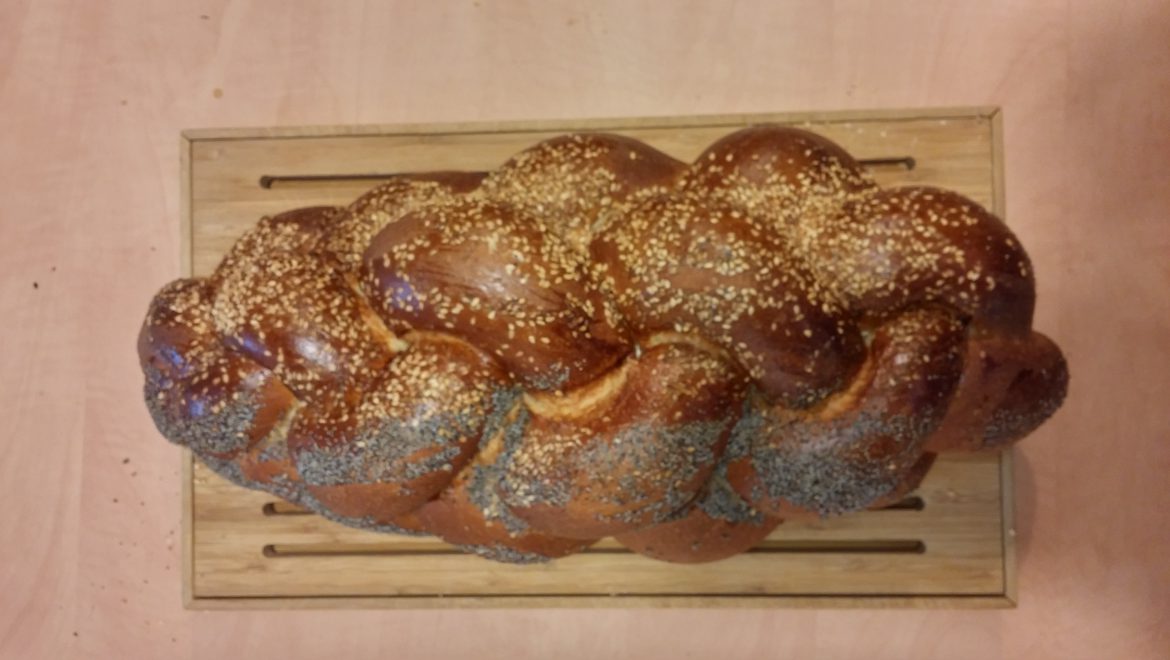
The following excerpt from “Shabbat Customs,” published by ReformJudaism.org, describes the various customs pertaining to the blessing over the bread on Shabbat, including the covering of the bread and knife, the amount of bread needed for a blessing, and how the bread is divided up and eaten. With transliterated and translated English texts of the blessing, this resource is particularly helpful for beginners. ReformJudaism.org provides content that describes and demonstrates the traditions and innovations of Reform Jewish life.
The Shabbat Challah
Challah refers to “dough” and specifies the special twisted loaf of bread eaten by Jews on Shabbat and other special occasions. Jewish tradition calls for a b’rachah (blessing) expressing thanks to God before eating any food. It represents a recognition that people owe a measure of gratitude to God for providing food for all living things.
Tradition holds that two whole challot (plural of challah) should be used on Shabbat as a remembrance of the double portion of manna that fell in the desert so that no Jew should have to gather food on Shabbat (Exodus 16:22-32). Another interpretation is that the two challot fulfill the biblical injunction articulated in the two versions of the Ten Commandments in the Torah: “Remember the Sabbath day to keep it holy” (Exodus 20:8) and ” Observe the Sabbath day to keep it holy” (Deuteronomy 5:12).
The challah is covered, often with a special decorative cloth before it is served. If a knife is used, it too is covered. The Rabbis used the challah as a vehicle to teach two important Jewish values: human dignity and the preciousness of peace.
As one looks at the Shabbat table, one notices that the Shabbat candles are in beautiful candlesticks and that the wine is held up in a lovely Kiddush cup. While the b’rachot over them are being recited, the challah lies alone on the table. The Rabbis, seeing this, decreed that the challah should be covered, lest its feelings be hurt by its seemingly secondary status. One rabbi said: “This teaches us concern for the feelings even of inanimate things. And if this is the case, how much more so we should be concerned about the feelings of human beings.” Thus, we cover the challot as a lesson in human dignity.
But why cover the knife? On Shabbat, our thoughts are of peace and harmony. The knife, in contrast, is seen as a weapon of war and violence. The knife is covered, then, to remove from sight any visible token of violence in the world. There is another tradition that no knife at all should be used, as a reminder of the prophetic verse: “And they shall beat their swords into plowshares and their spears into pruning hooks” (Isaiah 2:4). The challot are then broken apart by hand, with pieces distributed to all present. Whatever the practice, however, the lesson of the preciousness of peace is paramount.
Saying the Motzi over the Challah
1. The challot are uncovered and the Motzi blessing is recited as follows: Baruch atah Adonai, Eloheinu Melech haolam, hamotzi lechem min haaretz. “Blessed are You, Adonai our God, Ruler of the universe, who brings forth bread out of the earth.” Others sitting at the table should either join in reciting the blessing or answer “amen” at its conclusion.
2. The challot are then sliced or broken apart, with pieces distributed to all present.
3. Before eating the challah, it is also traditional to salt it. There are several explanations for this practice. One interpretation is that salt is a spice and thus appropriate to use on the special eve of Shabbat. Others explain that the salt reminds us of the biblical verse “by the sweat of your brow shall you get bread to eat” (Genesis 3:19). The challah thus serves as a tangible symbol of the Jewish values of gratitude to God, the uniqueness of people, the quest for peace, and the dignity and worth of every individual- all important and appropriate themes for Shabbat. There is also a connection to the sacrifices done in the Temple in Jerusalem, in which salt was used on all the offerings on the altar.

